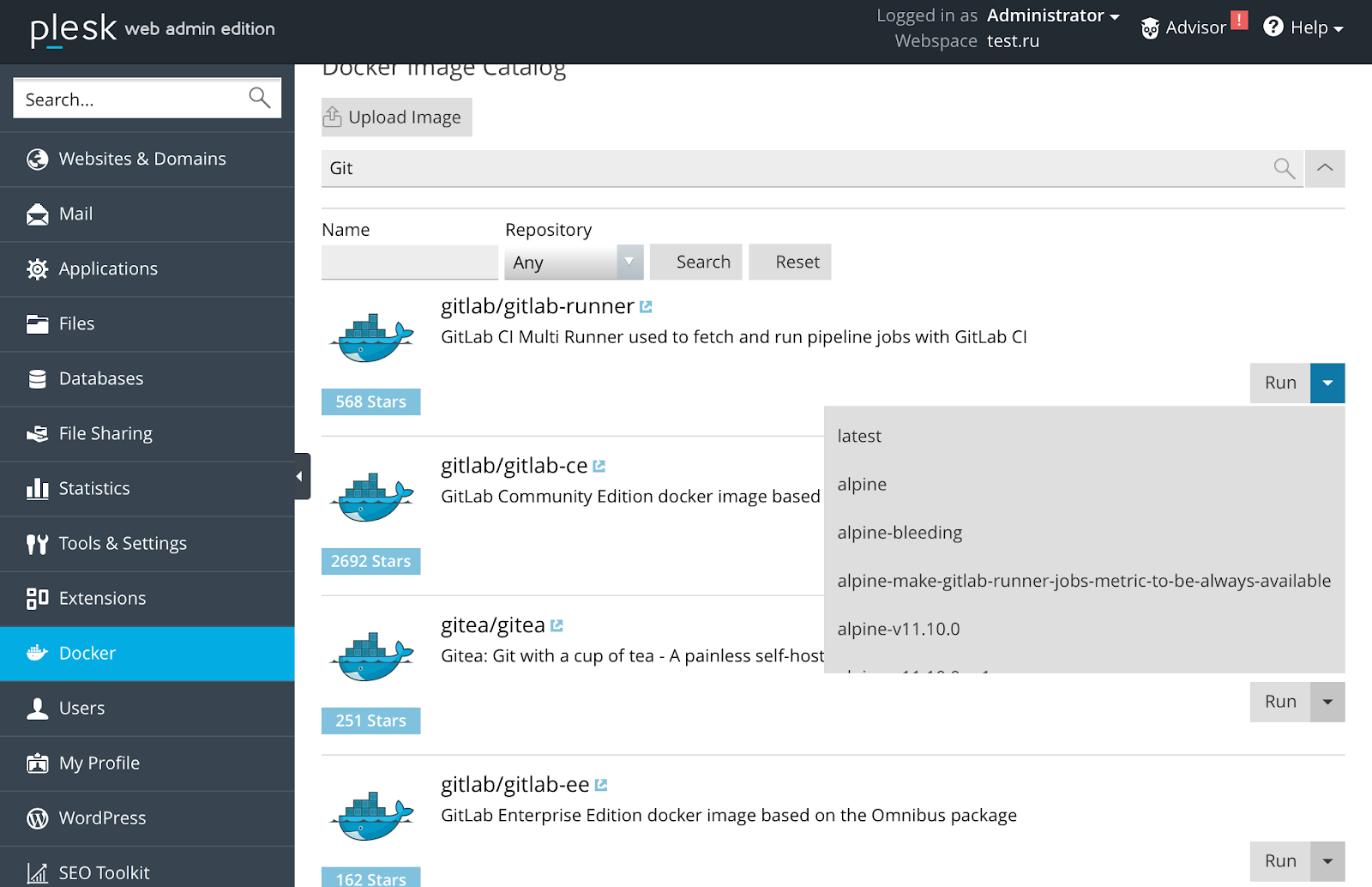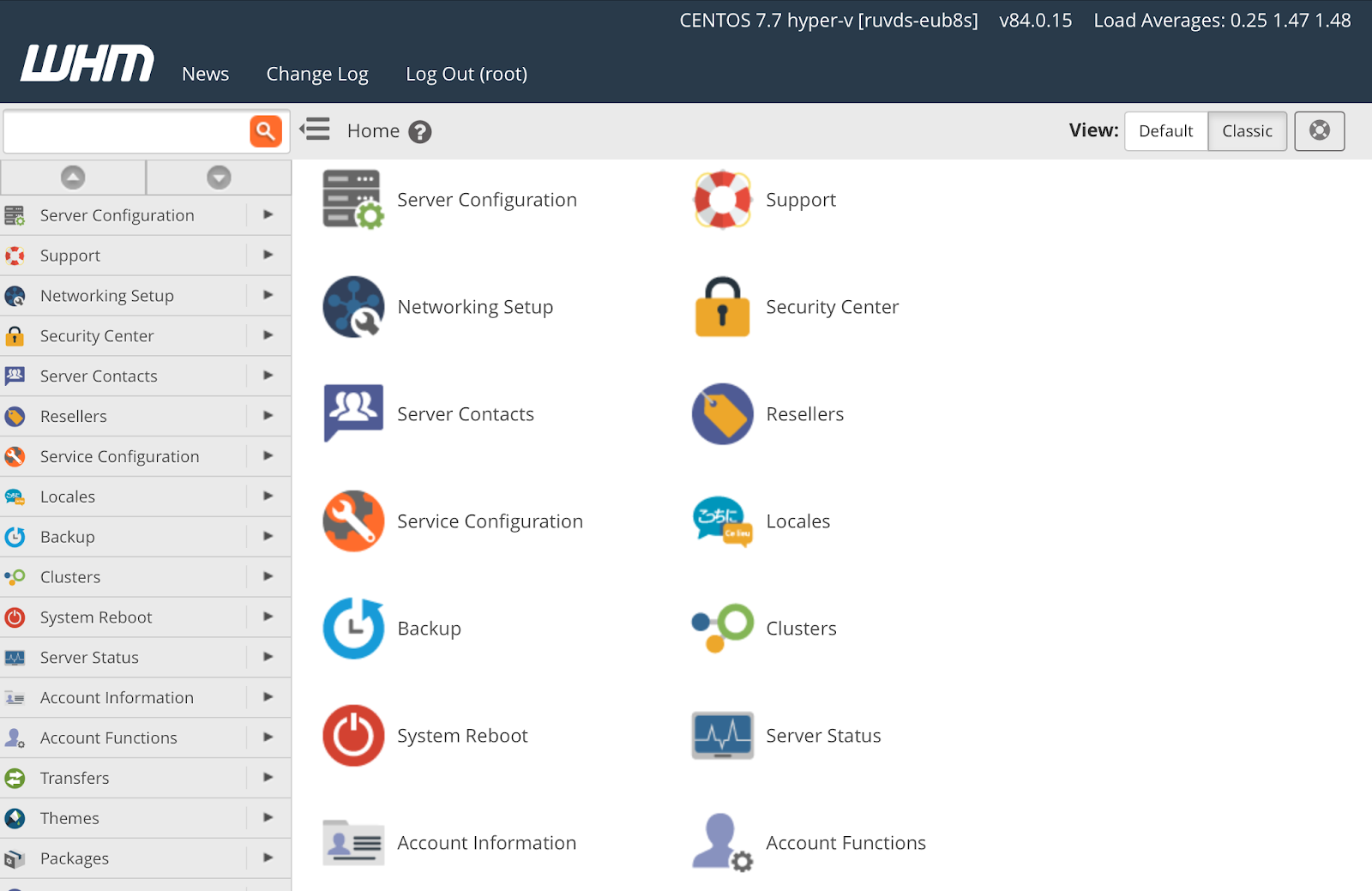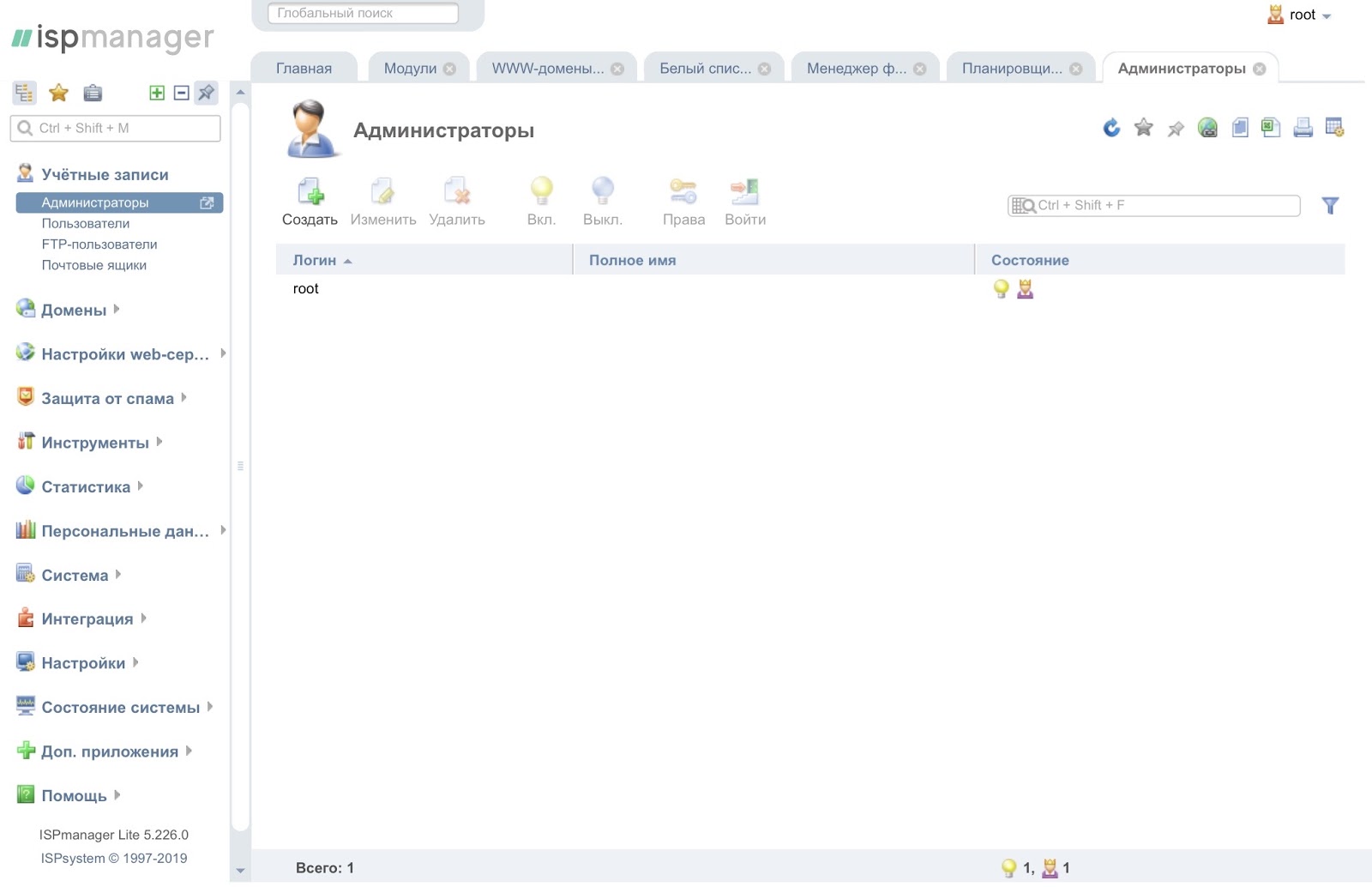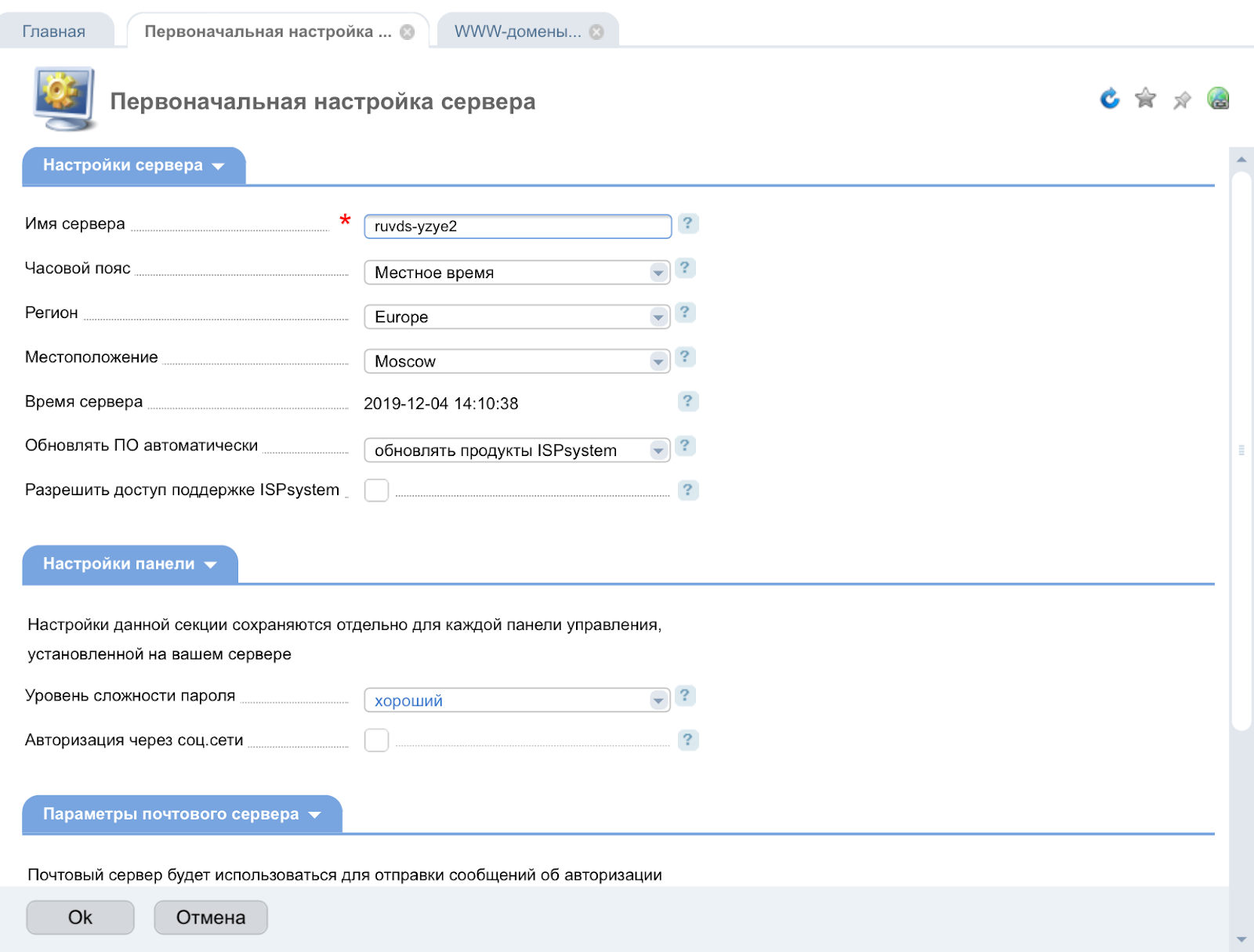
Difficulties arise when a client moves from OS administration to hosting-related tasks. He has to manage many sites with different CMS and numerous user accounts. To reduce labor costs, it’s worth installing the control panel that allows you to configure the corresponding services through a convenient web interface. It will also be needed for partners of the provider selling their services to customers. Today we compare three popular products available when ordering VPS and VDS on Linux.
Feature Overview
Plesk , cPanel and ISPmanager panels are proprietary software distributed under commercial licenses. To begin with, we compare their basic capabilities, reduced objectivity and clarity for the sake of one table.
| Plesk | cpanel | ISPmanager | |
|---|---|---|---|
| Supported OS | Debian, Ubuntu, CentOS, RHEL, Cloud Linux, Amazon Linux, Virtuozzo Linux, Windows Server | CentOS, CloudLinux, RHEL, Amazon Linux | CentOS, Debian, Ubuntu |
| The cost of a license for 1 host per month (on the developer's website) | $ 10 - $ 25 (up to $ 45 for a dedicated server) | $ 15 - $ 45 | ₽282 - ₽847 |
| Supported Web Servers | Apache
Nginx | Apache
Nginx testing support | Apache
Nginx |
| FTP access control | + | + | + |
| Supported DBMS | MySQL
MSSQL | MySQL | MySQL
PostgreSQL |
| Mail Service Management | + | + | + |
| Configure DNS domains and records | + (through an external service) | + | + |
| Installing scripts and CMS | + | + | + |
| Plugins / modules | + | + | + (small amount) |
| Alternate PHP Versions | + | + | + |
| File manager | + | + | + |
| Backup | + | + | + |
| Mobile app | For iOS and Android | - | - |
| Hosting organization (creating resellers and tariff plans) | There are in some editions | there is | Available in ISPmanager Business |
▍Plesk
One of the most versatile options, suitable for all types of tasks. The panel works not only with popular deb-based and rpm-based Linux distributions, but also with Windows. Although Windows VPS / VDS customers rarely need third-party administration tools, you can install them if you wish. Plesk also differs from its competitors in a large number of supported software, including rarely used on traditional web servers (Docker, NodeJS, Git, Ruby, etc.).
Developers offer different editions of the product, including a light version with a minimum set of features. Plesk allows you to choose the version of PHP for each site, supports PHP-fpm, has a built-in installer of popular CMS, as well as a huge number of extensions that complement the functionality of the panel. Depending on the edition, Plesk may include a billing panel, as well as the ability to create different tariff plans and resellers - the product is primarily intended for hosting companies and web studios, and for some VPS / VDS its functionality seems redundant. The main drawback of Plesk, which was identified at this stage, is the high price of licenses and the need to purchase extensions.
▍cPanel & WHM
This panel is designed to work with RedHat Enterprise Linux and with some derivative distributions. It is easy to use, but quite functional: cPanel allows you to manage web servers and databases, flexibly configure restrictions for hosting users, configure tariff plans, create resellers, and manage your mail service with filters and newsletters. As with Plesk, there are many additional features here, and cPanel features are expanded with commercial and free plugins. In addition, the tool allows you to select different operating modes and different versions of PHP. Of the serious drawbacks, a rather high license cost and lack of support for popular deb-based distributions can be noted.
▍ISPmanager
The last panel we reviewed differs from the others in low price. In addition, it works not only on CentOS (RHEL clone), but also on Debian / Ubuntu. The panel is optimized for hosting tasks and is updated automatically. Users can access detailed Russian-language documentation, the ability to set the PHP version for each site, and simultaneously install several versions of the DBMS inside Docker containers. PHP-fpm is supported, there is a built-in installer of popular scripts and CMS, as well as a number of integration modules expanding the functionality.
Prices for RuVDS
The table above shows the price range for Plesk, cPanel and ISPmanager licenses, if purchased on developer sites. Many hosting providers offer to immediately equip the server with a panel, while the cost of a license may be lower. As part of the New Year campaign, RuVDS gives customers who have ordered VPS the opportunity to use ISPmanager Lite for free until December 31, 2019, and Plesk web admin edition - until January 31, 2020. After the promotion, the cost of licenses will be 200 and 650 rubles per month. The trial version of cPanel can be used for free for 14 days, but then you will have to purchase the license directly from the developer.
First impression
Clients will not have any problems with installing and launching the panels, since we have already taken care of this - another reason (apart from the price) is to buy a license through a hoster. When ordering a server, just select one of the three available options: ISPmanager Lite, Plesk web admin edition or cPanel & WHM with a free trial period of 14 days. Note that although Plesk can run on Windows Server, this option is not provided out of the box. If you need a panel for the OS from Microsoft, you will have to install it yourself. This is common practice: VPS / VDS on Windows does not include third-party software. cPanel is available only for CentOS machines, which is also quite natural.

The initial setup and creation of sites will not cause any particular difficulties, however, the features of each specific panel are already important here. Let's try to highlight their strengths and weaknesses.
▍Plesk
The Plesk user interface is similar to the WordPress admin dashboard. On the left is the menu (navigation bar), and in the center is the workspace. The menu is organized quite logically, all settings are at hand. The interface is similar to the WordPress admin panel: we really liked the tight integration of Plesk with this popular CMS, the installation of which is extremely automated here. It is quite convenient to install other third-party scripts - this is a big plus.

In the right part of the window you can find additional interface elements that simplify the work with the panel. They contain a variety of information, allow you to quickly go to various sections of the settings, and also offer to install additional software. The main advantage of Plesk is the huge number of extensions and compatibility with exotic software for web hosting. We especially liked the Docker support out of the box and the rich set of ready-made images (you can also upload your own).

Finally, a small fly in the ointment: in Plesk web admin edition only basic functions are available, in more expensive editions their list is much wider. However, this is a common property of entry-level versions.
▍cPanel & WHM
Here we liked the separation of accounts into two types: users and administrators / resellers. In fact, the product consists of two different panels: cPanel itself and WebHost Manager (WHM). The first is intended for ordinary hosting users and working with it is quite convenient.

Features including the ability to create tariff plans for administrators and resellers are available through a special WHM panel. The interface of this panel as a whole is organized logically: the hiding hierarchical menu with a search bar is traditionally located on the left side, and the work area is on the right. It has a lot of settings and this is good on the one hand. On the other hand, the WHM menu cannot be called convenient. If in Plesk we almost never had to use search, here in each section there are so many options that the search string becomes the main administrator tool.

▍ISPmanager
An important difference between this control panel and the previous ones is the most simplified and intuitive interface. On the left is the navigation menu, and on the right is the workspace. You can open various menu options individually or simultaneously in the tabs of the workspace - this is very convenient because administrators often need different panel functions in parallel. In addition to those directly related to hosting, administrators have access to some additional, as well as system functions, such as anti-virus scanning, file manager, scheduler or firewall. The list of additional applications included in the package includes Roundcube Webmail and phpMyAdmin.

We liked the simplicity of the initial setup and the ability to automatically update the software, as well as the full Russian localization of the panel and all related documentation - foreign developments have difficulties with this. On the other hand, the simplified interface does not always have the necessary flexibility of settings, and the number of available additional modules for ISPmanager is vanishingly small compared to the collections for Plesk and cPanel. In addition, in the cheapest edition of Lite, you cannot create resellers and cluster configurations.

Security
The control panel gives administrators wide privileges in the operating system installed on the server and therefore the potential presence of vulnerabilities in it can be dangerous. By default, an encryption-enabled HTTPS protocol with a self-signed certificate is used to access the functions of all of the listed panels. In this case, no one forbids the user to install the purchased certificate. In addition, cPanel and ISPmanager configure two-factor login authentication for administrators / resellers and clients. In addition, cPanel has additional protection for administrative tools: for example, it does not have phpMyAdmin access via a direct link. Also, all three panels are regularly updated, they allow you to install SSL certificates for sites (including self-signed ones), and you can add various security-related modules to them, such as anti-virus tools.
Backup
Plesk supports full and incremental backups to its own storage or to an external resource. In this case, you can create both a full copy of the entire server, and a copy of the data of individual user accounts. cPanel creates compressed and uncompressed as well as incremental copies - by default they are saved locally. It is worth noting that it is possible to start the scheduled copying procedure and the lack of its own interface for data recovery.
The backup settings in ISPmanager, in our opinion, are not flexible enough, but there are also all the main features in this panel: the data is stored in a local directory or on an external resource and can be password protected. By default, the data of all users is copied, although this can be changed in the settings. In addition, the settings indicate the number of full and daily backups.
Advantages and disadvantages
All three panels reviewed top the lists of the most popular and are characterized by wide functionality. Plesk supports a variety of software and allows you to solve the widest range of tasks. More than 200,000 diverse Docker images are available to users, and the huge number of extensions makes Plesk a universal tool suitable not only for hosting. cPanel is designed to solve hosting-related problems, while developers divided access to different functions into two levels: separate panels were created for ordinary users and administrators. It is also worth noting the high demands on computing resources - cPanel should not be installed on low-power VPS. ISPmanager panel is also intended only for hosting management. It is easy to use, undemanding to resources and inexpensive - perhaps this is the best option for entry-level VPS or for novice administrators and hosters.

